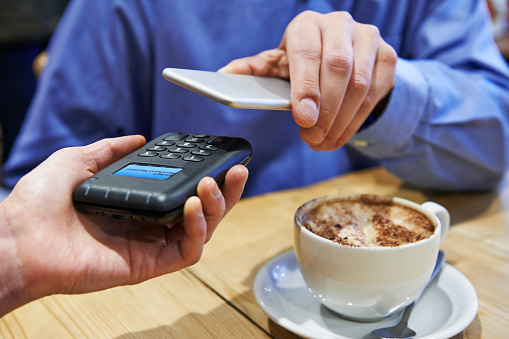The number of people making “mobile payments”—debit and credit card payments through a smartphone—is expected to increase exponentially in the next few years. However, if you’ve held back on trying mobile payments because you’re not sure how they work or worry they’re not completely safe, you’re not alone.
A survey by U.S. research firm Javelin found that more than half of consumers surveyed either wouldn’t use mobile payments or are neutral about them. The security of this new payment method was a major issue for 42% of Javelin’s respondents.
The good news is that paying with your smartphone may be much safer than you think. In addition, there are several things you can do to increase your smartphone and financial account security. Here’s what you need to know.
How Do Direct Mobile Payments Work?
At the most basic level, mobile payments involve downloading a payment app onto your smartphone. You then link your existing credit or debit card accounts to the payment app. (See “How to Get Started With Mobile Payments.”) You’re not opening a new card or bank account on your phone.
The technology that connects your smartphone to a physical cash register is Near Field Communication (NFC). This form of “contactless communication” allows two nearby electronic device to talk to each other without an internet connection.
The three main digital payment apps on the market right now are Apple Pay (for Apple phones), Samsung Pay (for the latest Samsung phones) and Android Pay (for most other Android phones). You can typically use mobile payments in person at payment terminals, within certain apps on your phone, and while you’re shopping online.
Some consumers may be more comfortable setting up mobile payments through their own banks, rather than a third party like Apple or Android, says Javelin. For this reason, Capital One and Barclays Bank, as well as other organizations, are also developing their own payment apps.
Why Use Mobile Payments?
Why would you bother putting financial information on your phone rather than just pulling out a credit card? Two main reasons: Convenience and added safety.
If you use multiple credit cards for different types of expenses or to earn different rewards, you may be carrying a handful of cards in your wallet. With digital payments, you can easily store all of your card information in your phone and leave most of your physical credit cards at home.
However, safety may be the bigger draw for many consumers. Generally, paying with your phone is actually safer than using a physical credit card. Digital wallet apps don’t store your debit or credit card information in your phone. Instead, they electronically link to your payment accounts.
Every time you use your digital wallet, your chosen payment app transmits a one-time-only code for that specific transaction—a security method known as tokenization. The three-digit CVC code (on the back of your physical card) also changes for each digital transaction. As a result, it’s virtually impossible for thieves to intercept your transactions and steal your payment information.
What if your phone gets lost or stolen? First, you need to unlock your phone in order to make any digital purchases. If you use a lock code or fingerprint ID to open your phone, it can help prevent thieves from accessing your phone. Second, you can use a computer to connect to your phone’s device manager and wipe your cards and other personal information from your phone.
How to Get Started With Mobile Payments
The setup is essentially the same for whichever smartphone payment app you choose.
Download or set up your payment app. Follow your particular device’s instructions. For instance, on an iPhone, go to Wallet and tap, “Add credit or debit card.” On a Samsung or other Android phone, download the Samsung Pay or Android Pay app from the Google Play Store and follow the instructions that appear on the screen.
Take pictures of your payment cards. Your payment app will use your smartphone’s camera to scan each credit or debit card you want to add. Don’t worry: Your phone won’t store an actual photo of your card. It simply uses the image to quickly gather your account information. You may need to manually enter each card’s CVC number. Typically, you can store multiple cards in your app, and choose one as your default card.
Verify your card. For your safety, the payment app will contact your bank. It will verify that your card can be used on the app, and that you’re the person making the request. Your bank (not the payment app) will text, email or call you with a verification code you’ll need to enter in your payment app.
How to Make Payments
In person. Unlock your phone and place it near the payment terminal. You may not even have to open your payment app (unless you want to choose from among several stored cards). Your phone should connect automatically with the cash register. A payment terminal that accepts digital payments will usually display payment app logos or the NFC logo—vertical wavy lines that look like radio waves.
Verification and payment. If you have an iPhone with fingerprint ID, Apple Pay will require you to authenticate the transaction with your finger. Other devices may require you to tap on a verification screen. On all devices, you can choose which stored card you’d like to use to pay, or select a default card that is used unless you specify otherwise.
Backup option. Since some retailers don’t yet accept digital payments —particularly some restaurants and gas pumps — you may still want to carry at least one physical payment card. That could also be helpful if your phone runs low on battery.
Sending Digital Payments to Others
The three major digital payment systems — Apple Pay, Android Pay and Samsung Pay — work well at physical payment terminals and online retailers. However, if you’re looking for digital payment options that also let you pay private individuals and organizations that don’t usually take debit or credit cards, you have some options.
You might use one of these methods to quickly pay your rent or pay back a friend for your share of a restaurant check. In most cases, you can use these payment methods via your smartphone, tablet or computer. Which one you choose is really a matter of personal preference. Some of your options include:
PayPal. Link your bank account, credit or debit card to the PayPal app and use it to make electronic payments to people and businesses who also have PayPal accounts for a small fee.
Square Cash. Link your accounts and transfer money immediately to other people and companies at no cost. Other people don’t need the Cash app to accept your payment.
Venmo. If you’re transferring money to another person, they also need to have a Venmo account. The company charges a small fee for paying via your linked credit card, and there’s a social media element to the app that some people might not like.
AmazonPay. Use the credit or debit card payment options you’ve already set up within your Amazon account to make purchases at selected online sites and within apps.
Keep Your Financial Information Safe
If worries over someone stealing your phone or your financial information are stopping you from trying digital payments, learn more about how to prevent identity theft and fraud. The more you know, the less nervous you may be.
In addition, there are many simple things you can do to safeguard your personal information:
Use your smartphone’s lock screen. Your phone can only process digital payments when it’s unlocked. That means that if someone steals your phone, they can’t access your payment information without unlocking it. Use a strong passcode or your fingerprint to unlock your phone.
Set up remote access to your phone. You can probably access your smartphone from your computer, but you need to set up this access before your device is lost or stolen. If your phone ever goes missing, you can remotely delete all of your personal information — digital payment information, email, photos, and more.
Monitor your financial accounts. Regardless of whether you use digital payments, you should regularly check your bank and card accounts for purchases you don’t recognize. If you see payments or purchases you didn’t make, contact your bank or card issuer right away in case your card is being used fraudulently.
Keep your software up to date. Make sure you’re using the latest version of your smartphone’s, tablet’s and computer’s software by selecting auto-update options for your devices. Older software often contains accidental loopholes that make it easier for hackers to break into your devices and accounts. Developers often learn about these vulnerabilities and fix them in newer software.
Still have questions about mobile payments? A representative at your local bank/credit union (and, if you have one, a tech-savvy child or grandchild!) may be able to explain more. In addition, many banks and credit card issuers, as well as every payment company (from Android Pay to Venmo), offer mobile-payment explanations on their website.
Do you use mobile payments? What steps do you take to make sure you’re sending digital payments safely?
Read more: How to Cyberproof Your Smartphone






